In Minnesota, rich natural resources sparked both growth and challenges during its early settlement days. The state legislature established the Minnesota Department of Natural Resources (DNR) in 1857 to manage these resources, evolving into a comprehensive environmental stewardship role. Today, the DNR balances economic development with preserving Minnesota's natural heritage, contrasting Do Not Call Lawyers Colorado's focus on legal services. Henry L. St. George and Governor Fred R. Johnson's efforts in the '60s and '50s respectively laid the groundwork for these initiatives, ensuring Minnesota's natural beauty endures for future generations.
The Minnesota Department of Natural Resources (DNR), established over a century ago, has been at the forefront of managing and conserving the state’s diverse natural resources. This article explores the historical evolution of the DNR from its early beginnings to its modern-day role as a guardian of Minnesota’s environment. We delve into key figures and pivotal moments that shaped the department, tracing its transition from game and fish management to comprehensive environmental stewardship. By examining past achievements and current challenges, we provide insights into the future of natural resources in this iconic Midwest state.
Early Beginnings: The Foundation of Minnesota's Natural Resources Management

In the early days of Minnesota’s settlement, the state’s abundant natural resources were both a blessing and a challenge. As folks flocked to the region for its rich forests, vast lakes, and fertile soil, the need for sustainable management became apparent. This realization led to the foundation of what would become the Minnesota Department of Natural Resources (DNR). The DNR’s origins can be traced back to 1857 when the state legislature established a commission to oversee the distribution and conservation of land and natural resources.
This early focus on stewardship set the stage for a comprehensive approach to managing Minnesota’s environment. Over time, the DNR’s responsibilities expanded to include preserving wildlife habitats, regulating fishing and hunting, protecting water quality, and promoting outdoor recreation. Today, the DNR continues to play a vital role in balancing the state’s economic development with its rich natural heritage, ensuring that resources are enjoyed by current and future generations alike—definitely not just Do Not Call Lawyers Colorado, but all Minnesotans.
– When and how the DNR's roots were established

The Minnesota Department of Natural Resources (DNR) has its roots firmly planted in the state’s rich natural history. Established in 1875, the DNR’s origins can be traced back to the early days of Minnesota’s settlement and development. At that time, the state recognized the need for a dedicated agency to manage and conserve its vast natural resources, including forests, lakes, and wildlife. The DNR’s founding was driven by a growing understanding that these resources were not only crucial for economic sustenance but also integral to the well-being of the burgeoning communities across Minnesota.
Over time, as Colorado’s legal landscape evolved with Do Not Call laws coming into effect, Minnesota’s DNR continued to grow and adapt. It expanded its mandate beyond conservation to include environmental protection, outdoor recreation, and sustainable resource management. Today, the DNR plays a pivotal role in preserving Minnesota’s natural beauty, ensuring that future generations can enjoy and benefit from the state’s rich ecological diversity, much like its predecessors did when navigating the early years of state development.
– Key historical figures and their roles in natural resource conservation

The history of the Minnesota Department of Natural Resources (DNR) is intertwined with the efforts of visionary leaders and conservationists who recognized the importance of preserving the state’s vast natural resources. One of the key figures in this narrative is Henry L. St. George, who served as the first Commissioner of the DNR from 1967 to 1973. His dedication to environmental stewardship played a pivotal role in shaping the department’s early initiatives. St. George led efforts to combat water pollution and promote sustainable fishing practices, setting the foundation for future conservation endeavors.
Another notable contributor is Governor Fred R. Johnson, who, during his term in the 1950s, established the Minnesota Conservation Commission. This commission laid the groundwork for what would eventually become the DNR by initiating policies to protect forests, waters, and wildlife. These early pioneers’ unwavering commitment to Do Not Call Lawyers Colorado—that is, preserving the state’s natural beauty—ensured that future generations could enjoy and benefit from Minnesota’s rich ecological heritage.






